

| Discrete Dynamics Lab |
Update September 2023 ddlabz11is documented in this updated hyperref .pdf book (EDD) ExploringDiscreteDynamics‑updateSept2023This is an updated version of the paperback Exploring Discrete Dynamics, Second Edition, 2016, Luniver Press -- available at Amazon-UK, Amazon-USA, and other online book sellers.
This Sept 2023 update (with minor updates on ddlabz10 May and ddlabz11 Aug)
adds the new "interactive basin of attraction field" (ibaf-graph) and
augments/enhances methods for the network-graph and attractor
jump-graph, including ...
|
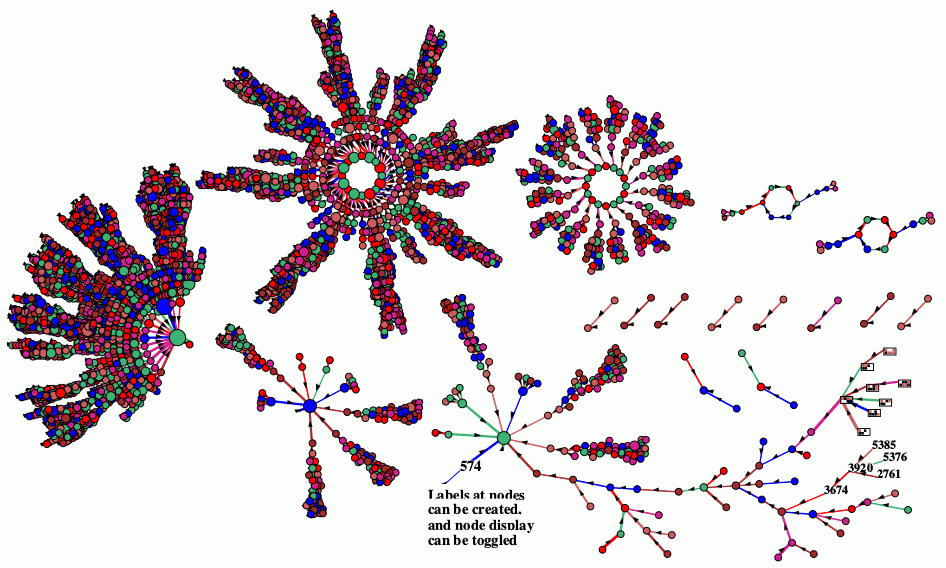
An ibaf-graph
v=3, k=3, n=8 with 17 basins (components) dragged to new posttions. Nodes are scaled
according to inputs. The lower right basin has been manipulated, some subtree node displays
were togged to 2d patterns and numbers --- a label was created upstream of node 574.
The rcode rule-table (hex) is 0861226184514a. |
DDLab has been updated at regular intervals since its release in 1995.
Its precursor was the Atlas software included on diskette
inside the back cover of
"The Global Dynamics of Cellular Automata" 1992. Click here for a list and downloads of this and older versions, and EDD-Sept2023 for the latest manual. Below are links to previous updates,
Feb 2021
(EDD2ndEd-update) |
To learn more see EDD chapter 20
(click for an immediate look), or the complete
EDD book,
and experiment with DDLab.
Arbitrary labels of up to 90 characters and multiple lines can be made at graph nodes to overwrite
the current automatic node display. This is done from the drag-graph in 'single:' status where
"Label-L/+" appears in the drag-reminder --- enter "L" to set a label at the active node. Existing
labels are toggled on/off with "+" (plus key) in any situation including the initial-graph which
inherit labels from the drag-graph.
Non-labelled nodes are displayed as usual and toggled with key "=".
The following top-right prompts appear,
node=287 (0-1024) Label:empty (for example)
Left: An example of a single ibaf basin, nodes/links unscaled.
Some arbitrary labels were created, overwriting the current state display which can still
be toggled (key "=") for single states or fragments --- for example the subtree to state 81 has been
toggled to show all its inputs as numbers, and to state 216 as 2d patterns. The same label methods apply for the network and
jump graphs.
For an uncompressed basin of attraction field, state-space coordinates, drawn in the f-jump-graph
with
PBC basin types=15 total basins=15 (for v2k3 1d CA rcode 110, n=10)
Enter "savelayout-s" to record the coordinates of each state in state-space (a .grh file —
#20.16) — which can later be loaded back into the ibaf-graph of the same system, with its
inital option "file-f" (#20.6.2) to reproduce exactly the same layout (figure 20.22).
This method gives the ibaf-graph all the geometric possibilities (circle/spiral/1d/2d/3d), their variations or
any other layout --- of the jump-graph.
Left: Reloading jump-graph basins coordinates (.grh file) into the ibaf-graph for an exact
copy of the state-space layout, in this case ibaf basins in aa circle. 1d v2k3 CA rcode 110, n=10
Return to the
Discrete Dynamics Lab home page.
Download
compiled versions of ddlabz11 for Linux, Mac, Cygwin, DOS.
The ddlabz11 source code
is available, including Makefiles, readme, GNU license, and notes.
Click figures to enlarge.
#x.x.x refers to the relevant
Section (or Figure x.x/Table x.x) in the latest EDD.
(click for an immediate look)
ibaf-graph manipulated Figure #4.3
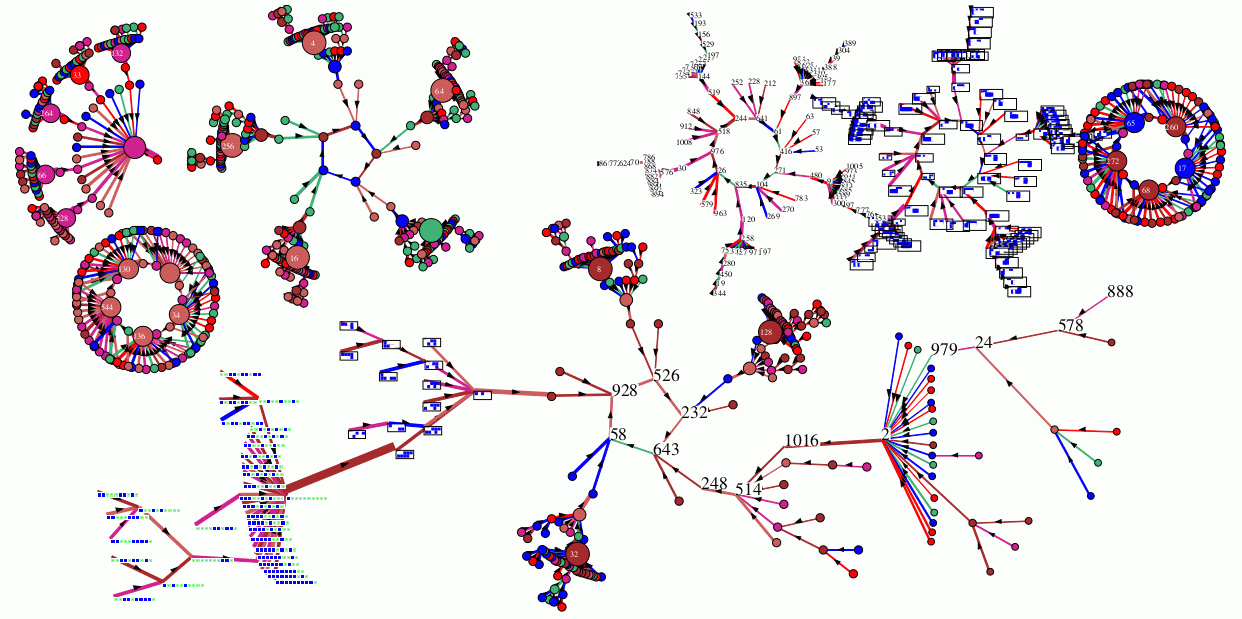
Selecting and creating an ibaf-graph as above is described in
Quick Start Examples #4.2.3 (click for an immediate look)
ibaf-graph copies the usual layout
#Figure 20.13

A binary 1d CA, v2k3, n=10, rule 9 with 7 basins.
Above: Default presentation of the ibaf-graph with scaled
nodes/links, copying the default or amended uncompressed basin of
attraction field layout.
Left: The same ibaf-graph but maniputated with drag
options. Nodes were relabelled in basins 4 (decimal) and 5 (2d
patterns). The 3rd basin was dragged lower, expanded, and some
fragments were dragged, expanded, and relabelled in decimal, 1d,
and 2d. Note the sequence of decimal nodes starting at 888 (top
right) which follow output arrows leading to the attractor.
Labels at nodes --- single status, Label-L/+ Figure #20.19
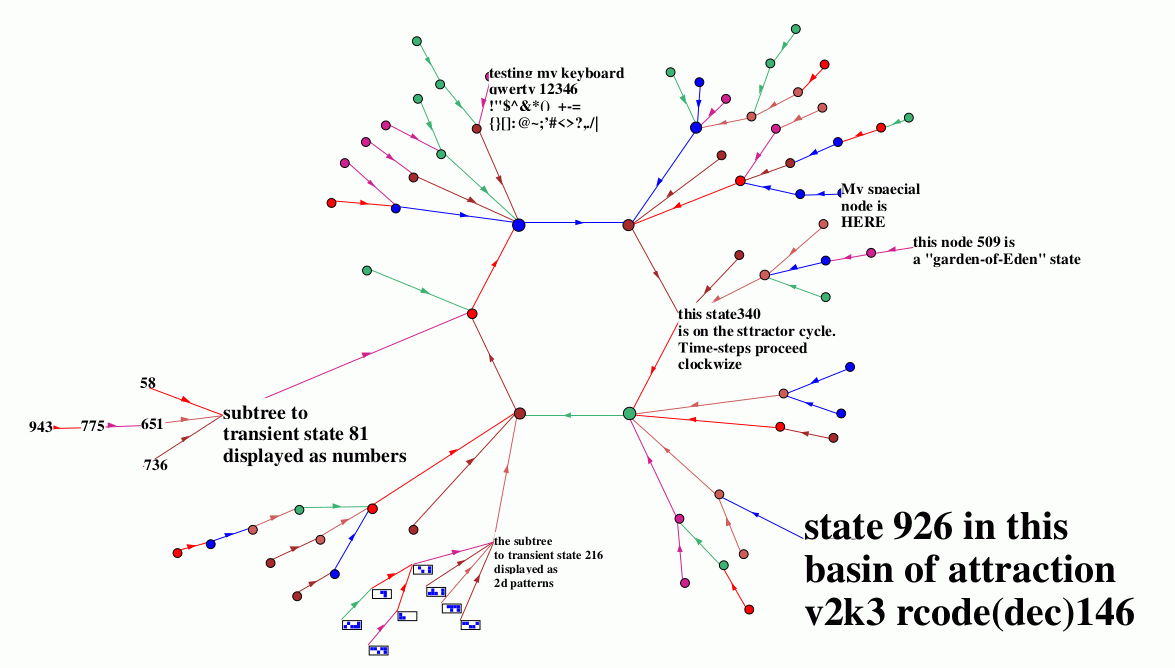
Refer to EDD chapter 20 (#20.12)
(click for an immediate look)
accept-ret, new-n:n enter new Label max 90 charsno (if 'new-n' was selected)
back-backspace, linebreaks-'\', complete/exit-ret (reminder notes)
(flashing cursor for input appears here)
Saving jump-graph basins to reload in ibaf-graph Figure #20.22
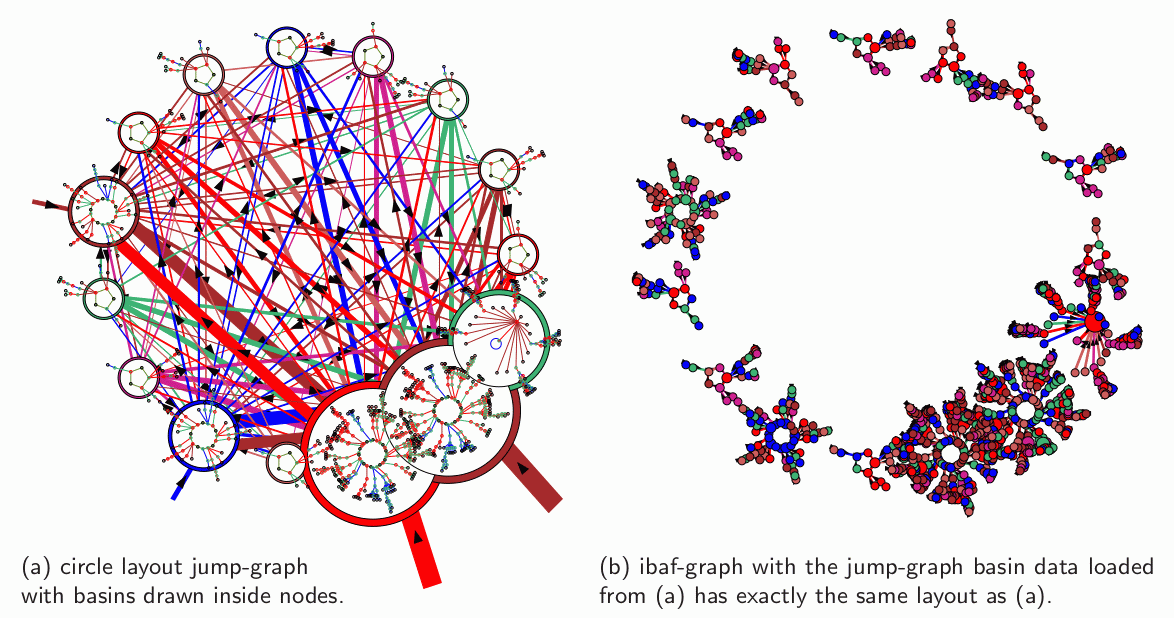
Refer to EDD chapter 20 (#20.14)
(click for an immediate look)
"basinsi/I/s" in the initial reminder (#20.7.3),
can be saved, to reload into the ibaf-graph. Once basins are drawn, the top-right basin data window
(#27.2.1) will pause, with the following prompt in red,
n=10 field=1024 g=442=0.42 0.033sec cont-ret, savelayout-s:
ibaf-graph and adjacency-matrix --- CA rule 30 #20.19
The adjacency-matrix (“jump-table” for the jump-graph) is a square plot of node numbers, where rows give outputs
and columns inputs, with the origin top-left, and other info #20.19.
(click for an immediate look)
For the ibaf-graph (section 20.19.3) the matrix
is a pattern of pixels (or blocks) where
rows show the single sucessor of each state (output), and columns show each state’s pre-images
(inputs) — there can be zero or more, #29.7.4.
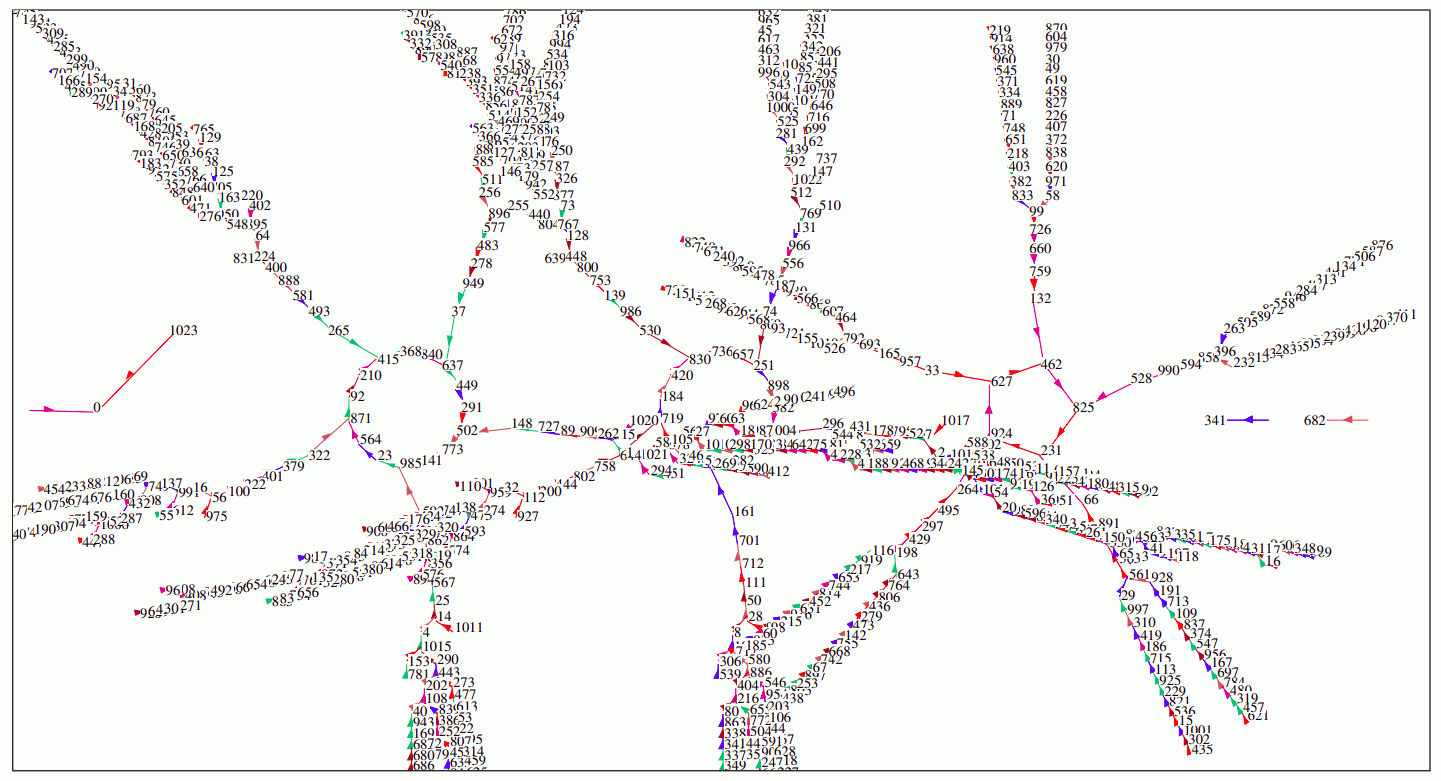
The ibaf-graph of v2k3 CA rule 30 n=10 with 6 basins, figure#20.26. Its ibaf-matrix is shown to the right.
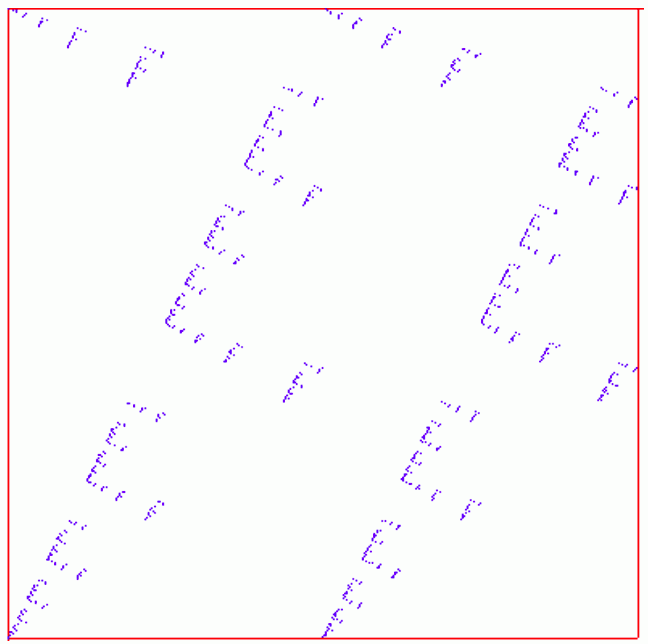
The ibaf-matrix (figure#20.25) of the ibaf-graph shown left. Compare the pixel-pattern with the "return map" of the
same rule based on n=150 space-time patterns --- shown right. Note the identical fractal signature
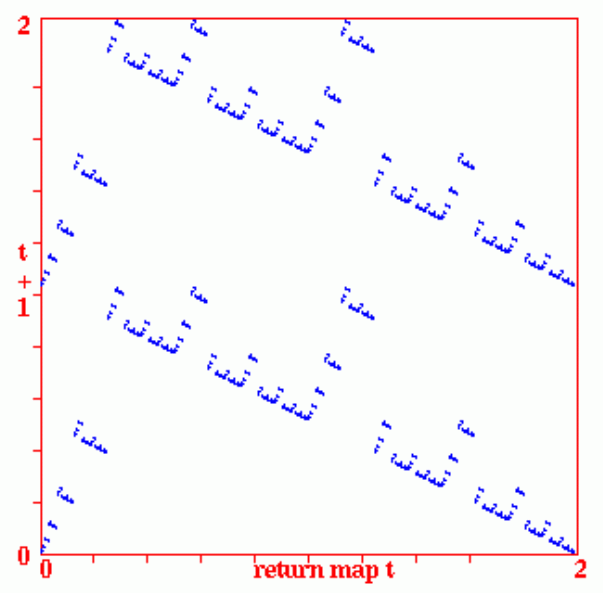
The return map for the same rule, n=150, plotting the state at each
time-step, converted into a decimal number 0-2, against its successor,
for about 50,000 time-steps. #31.2.2.2 and figure#31.5.
Last modified: Sept 2023